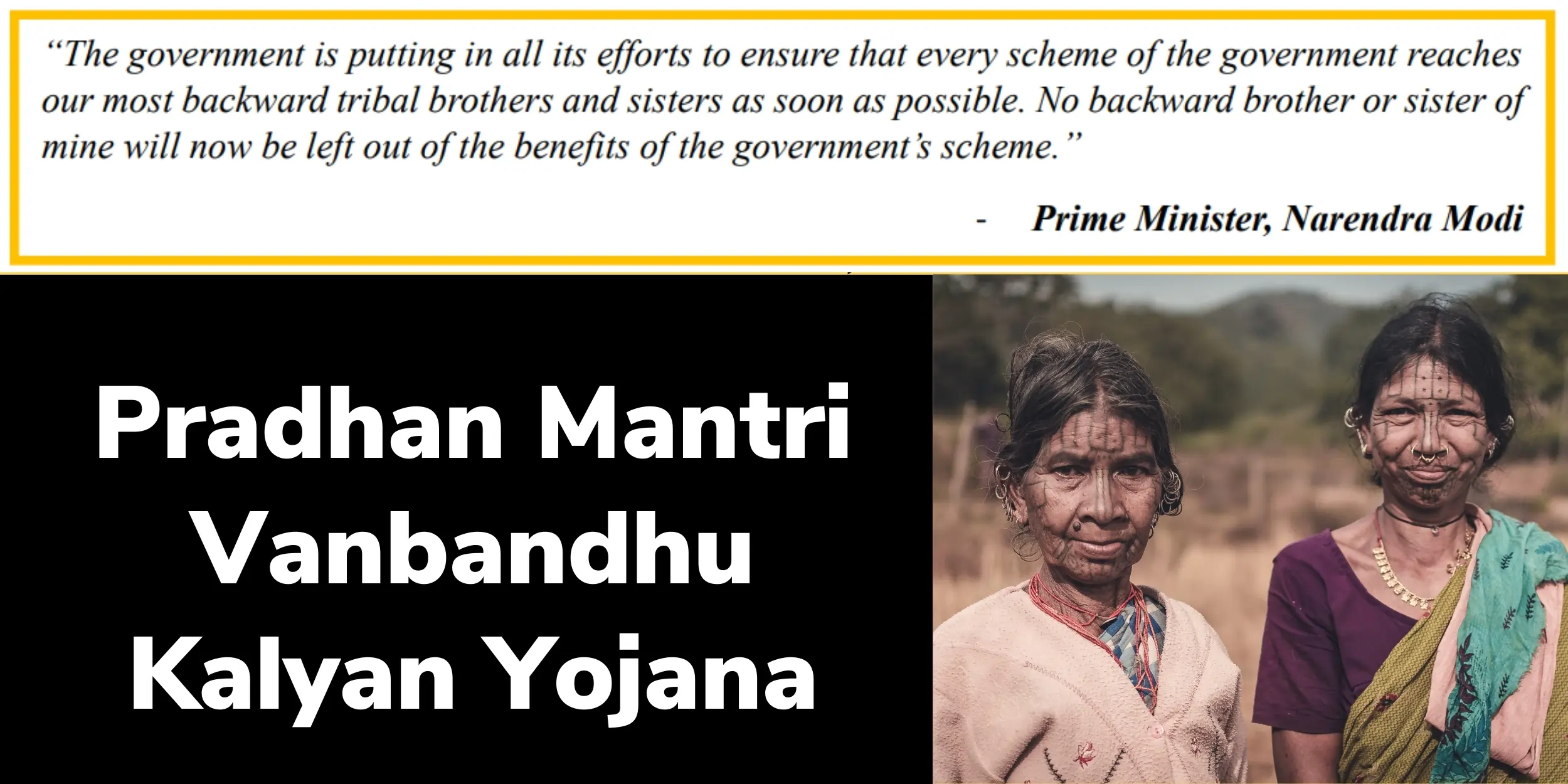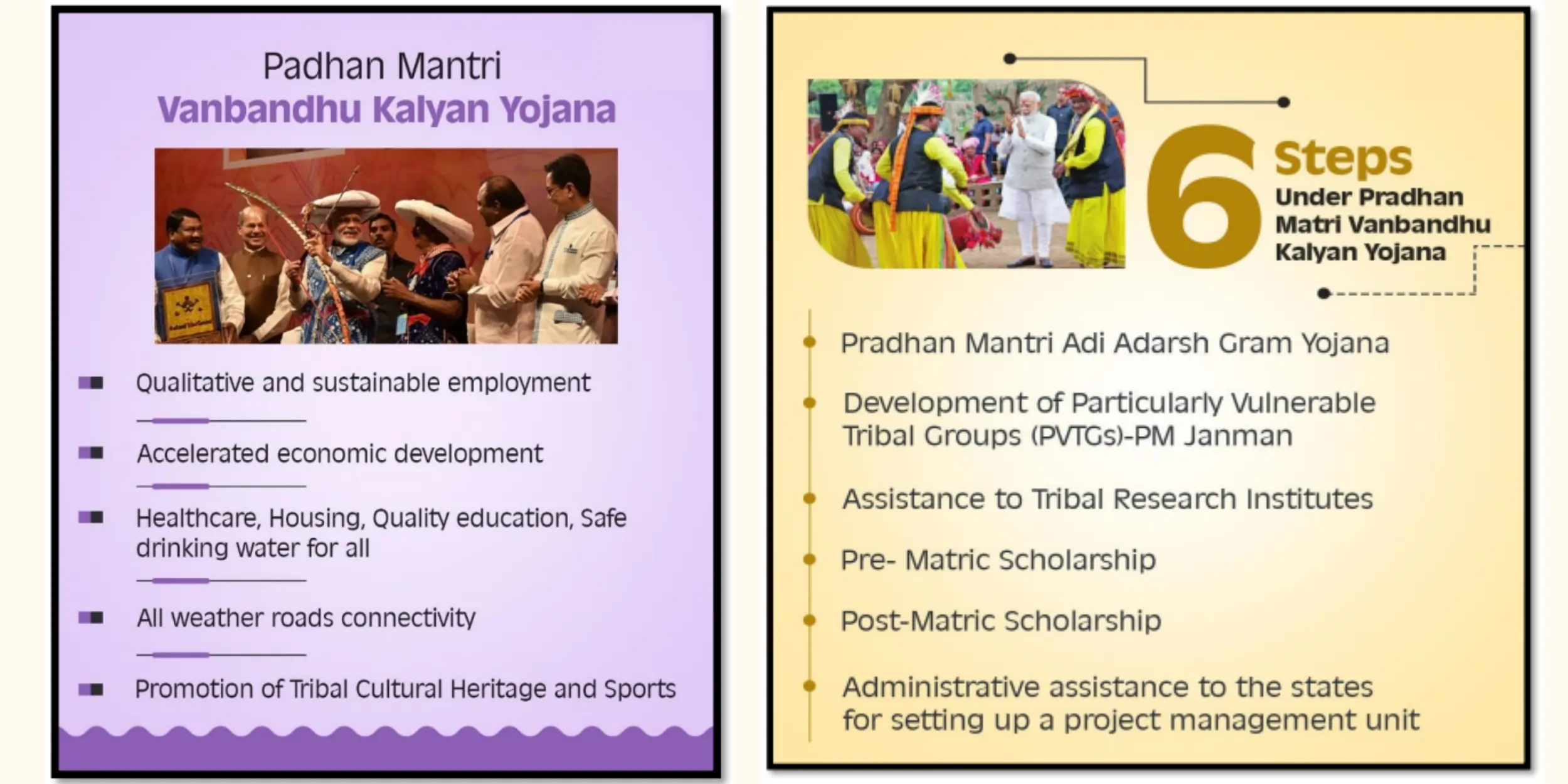
Pradhan Mantri Vanbandhu Kalyan Yojana (PMVKY) is one of the Strategic direction devised and started by the Indian government on 28th October, 2014 to improve the quality of life of the tribal population of India. Tribals composing 8.9% of the countries’ population is usually characterized by substantial complexities to their social and economic status, as well as have long been discriminated. In response to such issues, PMVKY is set to design a broad-ranging strategy that embraces not only the essential areas of development but also more socially responsible effective means and ends pursued for the sake of sustainable growth.
The main idea that permeates PMVKY is the concept of Inclusive development as enunciated by the Hon’ble Prime Minister of India Shri Narendra Modi Ji that says ‘Sabka Saath Sabka Vikas’ (Collective effort, development for all). This scheme is formulated to enhance the social and economic standards of life amongst the tribal people with keeping their ethos and ethnicity in mind. To establish a societal context for self-employment and productiveness for the tribal populace in the overall development of the country, the PMVKY was set for ₹26,135.46 crores for the fiscal period of 2021-22 to 2025-26.
Pradhan Mantri Adi Adarsh Gram Yojana (PMAAGY) being one of the major components of PMVKY, is aimed at the integrated development of 36,428 villages with sizeable tribal population. This program focuses on sectors like road and telecommunication infrastructure, education facility, health and sanitation, with an intention to improve the quality of life in the tribal populations. As a result, PMAAGY intends to address the problems in the areas of infrastructural and the basic amenities with aim of coming up with model villages.
There is no doubt that PMVKY has another large component focused on the Developing Particularly Vulnerable Tribal Groups (PVTGs). The scheme, called the Pradhan Mantri PVTGs Development Mission started in 2023-24 focuses on providing basic needs of protection of habitation, clean drinking water and sanitation facility, education, health and nutrition. This initiative also appreciates the position of the most vulnerable tribal people and seeks to transform their lives through directional support.
It additionally also gives priority to education and capacity building elements of the scheme. PMVKY provides opportunities and support for tribal students through schemes include Pre-Matric Scholarships, Post-Matric Scholarships, and more significantly, support to Tribal Research Institutes (TRIs). Through investment in education they expect to transform the tribal youths through availing education which provides them with necessary tools for surviving in society that is becoming more and more complex by the day.
However, other than the above efforts, PMVKY also aims at Livelihood development and financial inclusion. To achieve the goals of the scheme, financial assistance and support is provided for income generating activities so as to ensure sustainable incomes for the tribal populace. This includes encouragement of traditional arts and crafts, farming and petty trading which are staple incomes for the tribal groups.
The scheme also considers the need of cultural and community revelation of tribal people. The practice by PMVKY of traditional practices, languages and customs is again aimed at making sure that the tribal people are not left behind while at the same time embracing some of the development issues which are prevalent in most parts of the country.
6 key steps under Pradhan Mantri Vanbandhu Kalyan Yojana
PMVKY is a schematic program that aims to support and transform the tribal demography of India. This scheme advocates various complex ways to handling out these problems affecting these vulnerable groups. Here are six key steps under PMVKY:

1. Pradhan Mantri Adi Adarsh Gram Yojana (PMAAGY)
PMAAGY is actually the core of PMVKY which is dedicated to make villages with tribal peoples into model village. Integrating with innovative programs for the agricultural value chain, this program targets basic infrastructure like roads and telecom links, water and sanitation, health facility, schools and other education needs. Thus, establishing the enabling environment and enhancing the living conditions, PMAAGY is planning to promote the sustainable development and determine the indicators of the development of the tribal village.
2. Development of Particularly Vulnerable Tribal Groups (PVTGs).
PVTGs therefore, comprises of some of the most disadvantaged communities in the Society. According to PMVKY, the specific interventions are undertaken for PVTGs’ development that includes their right to shelter, access to drinking water, sanitation, education, health, and nutrition. It holds a parameter that addresses the specifics of PVTGs and supports their inclusion into the community, while offering multi-dimensional development.
3. Support to Tribal Research Institutes (TRI)
Today, TRIs are invaluable in maintaining the cultures of tribes and in conducting academic research on tribes’ matters. These institutes are helped by PMVKY to increase their research work, course preparation and surveys on multipliable aspects of the tribal society. TRIs are essential to generate research and documentation to help policy makers learn more about the tribal communities and address their needs accordingly.
4. Pre-Matric Scholarships
Education was found as a factor for education and PMVKY has stress on providing education for children belonging to tribal areas. These scholarships are given before the matriculation level to help remove the financial problem of attending school among the tribal kids. These scholarships seek to address enrolment statistics as well as learning achievement levels by paying for such costs as tuition fees, books, uniforms and other stipend necessaries targeting enhanced enrolment in tribal institutions.
5. Post-Matric Scholarships
In addition to the post-matric scholarships are given under PMVKY for ST students studying higher education after 10+2. These are scholarships that provide funds for higher secondary, college and University expenses including tuition fee. The Outlay of PMVKY seeks towards improving higher education so that tribal youth are able to acquire social and economic mobility and included skilled employment.
6. Administrative Assistance for Project Management Units PMUs
In this aspect, sound deployment and tracking of development activities are pivotal to their success. PMVKY supports capacity building to facilitate effective and improved formation of PMUs at different tiers. It is these units that are required to undertake planning and coordination of the scheme and its implementation oversees the respective projects from the particular plan. In this respect, PMUs are crucial for the effective planning, tracking and realisation of the objectives of PMVKY and provision of the beneficial impact on the tribes.
PVTGs
PVTGs are considered as some of the most backward and disadvantage needy groups in Indian society. These people are separately categorized by the Indian government to target the different problems they face and the different policies that they require. Today, there is 75 PVTGs which are very different in terms of culture, way of life as well as problems they face.
Historical Background and Identification
About the PVTGs, the Dhebar Commission in 1973 came up with criteria for identifying some tribes that were particularly vulnerable. Such criteria are;
- Pre-agriculture era level of technology, no or declining population, negligible literacy, and subsistence level economy. The idea was to guarantee that these groups acquired requisite support to enhance their socio-economic standing.
Socio-economic Challenges
Inclusion of PVTGs involves considerable difficulties due to the complex of problems that prevent their successful development. Among them the biggest problem is the absence of the elementary human needs including healthcare, education and clean drinking water. Another reason why PVTGs are considered to be vulnerable is that they live in isolation because most of them are situated in regions that are hard to access. The standard of living of such people remains poor according to the incidences of malnutrition, infant mortality as well as diseases. Yet another sector that seems to have been severely affected by the plight of the PVTGs is education. The literacy rate of these groups is considerably low than other regions Main of the children can be forced to drop from school since there are few schools that offer teaching facilities and materials. This conspires to keep them in a continuous state of poverty and hinders their chance for socio-economic mobility.
Culture and the Environment
PVTGs have their customs and culture that define their community in every aspect as a people. But today the forces of modernization and globalization encroach upon traditional cultural values of these peoples. Majority of PVTGs are more depending on primary produce that include shifting cultivation, hunting and collecting. Encroachment and deforestation among others have affected their ecosystems, which has for instance made it almost impossible for them to meet their food requirements.
Government Initiatives
The central government has started various programs and policies specifically for the development of PVTGs. The first among them is the Development of Particularly Vulnerable Tribal Groups (PVTGs) Scheme wherein integrated support in terms of dwelling, health, education, and employment etc. The concept of the scheme is to upgrade the quality of life because PVTGs involved in various activities meet different problems and need further development.
The Pradhan Mantri Vanbandhu Kalyan Yojana (PMVKY) also provides for the development of PVTGs attaching priority for safe, secure and sustainable housing, supply of clean drinking water, sanitation, education, health, and nutrition. For this purpose, the central government and its line ministries have launched several schemes and programme to empower and assimilate PVTGs into the main stream society.
Participation of NGOs and Community Role
Barely a decade ago, NGOs have become complementary to the governments to help extend support to PVTGs. A number of NGOs operate at the community level delivering services, support and capacities. People and particularly community members also play a role for development interventions to succeed. Mainstreaming PVTGs working decision-making progress means increasing their ability to make their own decisions and promoting their specific requests.
Future Prospects
Although considerable advancement has been achieved in transforming the fate of PVTGs, there is much that remains to be accomplished. We can understand that for the sustainable development of such communities they must be provided adequate infrastructure related facilities, basic education, employment opportunities etc. The people also need to retain their cultural practices and knowledge as it is their portfolio of their origins.